
Halloween - Pompions and Ghostly Tales: 1 2 3 4 5 6 Next>>
Pompions, Monsters and Ghosts in the Golden Age of Piracy, Page 4
Some Popular Halloween Creatures in Golden Age of Piracy Literature
What would Halloween be without the tried and true traditional monsters such as Werewolves, Zombies and other such creatures? Although many of these beasts have been given modern make overs in an attempt to make them more appealing to the modern audience, their roots go far back, beyond even the golden age of piracy. Fortunately they are durable enough to find a place in the time period when the pirates were most active in history. Let's look at some of these monsters.
Were Creatures
Wikipedia tells us the word 'werwolf' first appears in the 11th century in the writings of the colorfully named Burchard von Worms [Bishop of Worns],

Werewolves Attacked and Attacking - An Image of
Alleged
1589 Werewolf Peter Van Stumpp
but the actual belief in men transforming into wolves doesn't really catch the public's interest in Europe before the 14th century.1 Once the lycanthrope caught the public's imagination, however, it became a feature in the tales of the strange and horrifying. Wikipedia explains that "Like the witchcraft trials as a whole, the trial of supposed werewolves emerges in what is now Switzerland (especially the Valais and Vaud) in the early 15th century and spreads throughout Europe in the 16th, peaking in the 17th and subsiding by the 18th century."2
I have not come across any shipboard examples of were-creatures, probably because it would be a difficult myth to try and sustain; most ships were fairly small and the men were usually well known to each other. However, barber-surgeon Johann Dietz does provide us with another diverting supernatural tale, this one featuring a werewolf, albeit in a land-based environment. I have again added paragraph breaks.
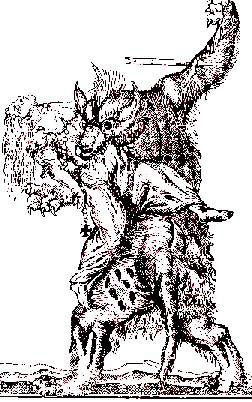
Woodcut of Werewolf Attacking a Woman
Unknown Author and Date
The major commanding our regiment had a wife who showed but little good feeling towards the poor fellows in billets. As she was going one evening about twilight to a country house, a wolf fell upon her in her own court-yard, threw her down, and came near to tearing the whole of her face to ribbons.
Her servants came running up when they heard her shrieks, just as the wolf escaped by jumping over the garden wall. A number of soldiers ran after him, but they saw nothing of him. I had to attend her and bind up her wounds and let blood.
Then Major Herest came home, and swore that he would repay the wolf! — For this purpose, he placed loaded firearms charged with bullets of antimony in constant readiness.
Scarcely a week had gone by when the unwelcome visitor returned by way of the garden wall. The major was straight-way summoned, and shot the wolf so that he rolled over and over.
A great crowd of people had collected; and they drove the werewolf before them with spears and stakes, right past my door. I have never in my life beheld such a sight. They too shot at him, but nothing came of it. They drove him out of the town, and there he got away just as they seemed to have caught him.
There were indeed some who insisted that they had found in her den an old woman who had been shot in the hip. Now, while I did not see this I do not say that it was impossible; for one often hears of such miraculous though devilish transformations.3
There are two points worth highlighting in this story. First, note that the major used "bullets of antimony" for hunting this creature. Antimony was identified as a metal in the 17th century, although it was recognized as a unique substance long before that.4 It is a soft metal, so it could have been used to make bullets. About.com explains that it "was sometimes symbolized [in alchemy] by the wolf. The metal antimony represents man's free spirit or animal nature."5 Why this would make it the proper metal for killing a werewolf is not entirely clear.
Also of interest is Dietz's response to the wolf bites. Regular readers of the surgical articles on this web site could probably have guessed that 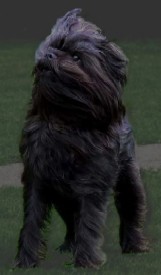
Photo: Jimmy Jet
Black Dog at Night
blood-letting would be the most likely cure for something as extraordinary as a werewolf attack. (I suppose the logic here might be that bad humors would form at the wound site, possibly increased in potency by the black magic behind them. Note that Dietz makes no such assertions, I am just trying to get into the 'spirit' of things.)
In French surgeon Ambroise Paré's chapter "Of Monsters and Prodigies" he gives two secondhand descriptions of lycanthropic events. The first is taken from naturalist Pliny the Elder's (Gaius Plinius Secundus) works. According to Paré, Denarchus, "tasteing of the entrails of a sacrificed childe, turned himself into a Wolf."6 What happened as a result is not recorded in Paré's book.
The second is a more detailed lycanthropic account given directly to Paré by the man to whom it occurred. According to Paré, the man "riseing out of his sleep, and not finding drink, took an apple that hee found by chance, and eating it, hee thought his jaws were shut and held fast as by ones hands, and that hee was almost strangled"7. The man claimed eating the apple possessed him 'of a devil' causing him "to bee devoured of a huge exceeding black dog, which hee, afterwards restored to his former health... There were divers, who by his puls[e], heat and the roughness of his tongue, thought him to bee in a fever, and by his watching, and the perturbation of his minde, thought him onely to rave."8
1 Werewolf, wikipedia, gathered 10/6/13; Johnson, p. 85; 2 Werewolf, ibid.; 3 Johann Dietz, Master Johann Dietz, Surgeon in the Army of the Great Elector and Barber to the Royal Court, Translated by Bernard Miall, p. 166-7; 4 Antimony, wikipedia.com, gathered 10/15/13; 5 Antimony or Stibnium, About.com Chemistry, gathered 10/15/13; 6 Ambroise Paré, The Workes of that Famous Chirurgion Ambrose Parey, p. 669; 7 Paré, p. 668; 8 Paré, ibid.
Zombies
Before the mysterious illness-induced, human brain-munching zombies of popular cinema, there were voodoo-spawned sort among
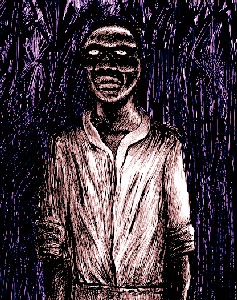
Artist: Jean-noël Lafargue
A Haitian Zombie in a Corn Field
the natives in Africa and Haiti. Like their modern-day equivalents, these creatures were usually dead people who revived by voodoo priests (bokors), sorcerers or witches.1 These creations were said to have no will and were sometimes used as slaves.2
Africa was one of the corners of the triangle trade in which slaves were purchased to sell in the Caribbean. This resulted in sailors coming in contact with the dark continent. In his accounts, sea captain Nathaniel Uring mentions 'zumbies' as he is explaining the funeral procedures observed in Loango [located where the Republic of the Congo is today].
...at the Death of a Person, it is customary for them to kill Hens, and sprinkle the Blood both without and within-side the House, and then throw the Carcasses of the Fowls upon the Top thereof, affirming, that thereby they prevent the Spirit of the dead Person from coming to give Zumbi to any of the future Inhabitants; the Word Zumbi signifies the Apparition of the dead Person, they being of Opinion to whomsoever it shall appear the Person will presently die.3
Unfortunately Uring doesn't give us any further detail on these creatures. In many ways, his description almost makes them sound like ghosts.
1 Zombie, wikipedia, gathered 10/8/13; 2 Ibid; 3 Nathaniel Uring, A history of the voyages and travels of Capt. Nathaniel Uring, p. 67
"Of Monsters and Prodigies" - Land Creatures
We've

Horned "Monster" from The
Workes of That Famous
Chirurgion Ambroise
Parey, p. 651 (1649)
already seen a few creatures that were featured in French surgeon Ambroise Paré's "Of Monsters and Prodigies". This chapter, which appears in the 1649 English translation of his Oeuvres, is originally from an extraordinary book that Paré published in 1573 that talked about and pictured all sorts of unusual natural phenomenon.
Paré divided these creatures into two groups - hence the title Monsters and Prodigies" As he explains it, "We call Monsters, what things soever are brought forth contrarie to the common decree and order of nature. So wee term that infant monstrous, which is born with one arm alone, or with two heads."1 With this description in mind, the first part of his book focuses on what we call congenital disorders, featuring conjoined twins, extra and oddly placed appendages and so forth.
The real interesting part of the book for our Halloween theme are the prodigies. As Paré explains, "wee define Prodigies, those things which happen contrarie to the whole cours of nature, that is, altogether differing and dissenting from nature: as if a woman should bee delivered of a Snake, or a Dog."2 Even that sounds a bit less monstrous than one might expect to find in an article on Halloween, but it must be remembered that Paré was first a surgeon and wrote from that point-of-view. Fortunately, he featured stuff that might have found its way into a 50s B Horror film.
It is worth noting before exploring the beasts featured in the prodigy section of Paré's book that none of them are based on direct observation by the master surgeon. He is merely repeating what others have reported. He even goes so far as to say that "the Painter hath shewed his skil too much in the one"3, advising the reader that some of the creatures could not have been as extraordinary as they have been rendered.
Pare's work speaks fairly well for itself, so I am going to bow out for the remainder of this section and let the good surgeon do the talking. I have inserted some additional paragraph breaks for clarity.
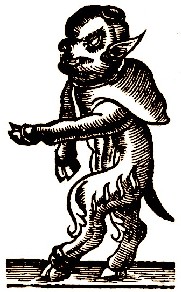
Calf-Faced Monster, The
Workes
of That Famous
Chirurgion
Ambroise
Parey, p. 660 (1649)
"In Stecquer a village of Saxonie, they say, a monster was born, with four feet, eies, mouth, and nose like a calf, with a round and red excrescence of flesh on the forehead, and also a piece of flesh like a hood hung from his neck upon his back, and it was deformed with its thighs torn and cut.
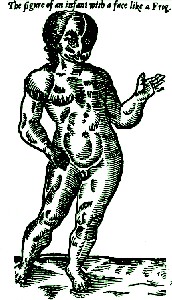
Frog-Faced Monster, The
Workes
of That Famous
Chirurgion
Ambroise
Parey, p. 660 (1649)
Anno Dom. 1517. In the parish Kings-wood, in the forrest Biera, in the wai to Fontain-Bleu, there was a monster born, with a face of a Frog, beeing seen by John Bellanger, Chirurgian to the King's Engineers, before the Justices of the town of Harmoy, principally John Bribon the King's procurator in that place.
The father's name was Amadeus the Little, his mother's Magdalene Sarbucata, who troubled with a fever, by a woman's perswasion, held a quick frog in her hand until it died, shee came thus to bed with her husband and conceived; Bellanger, a man of an acute wit, thought this was the caus of the monstrous deformitie of the childe."4
"Anno Dom. 1493. there was generated of a woman and a dog, an issue, which from the navel upwards perfectly resembled the shape of the mother, but therehence downwards the fire, that is, the dog. This monster was sent to the Pope that then reigned, as Volaterane writecth: also Cardane mention's it; wherefore I have given you the figure thereof [below left]."5
"Celius Rhodoginus write's that at Sibaris, a heards-man called Chrathis fell in love with a Goat, and accompanied with her, and of this detestable and brutish copulation an infant was born, which in legs resembled the dam, but the face was like the father's."6
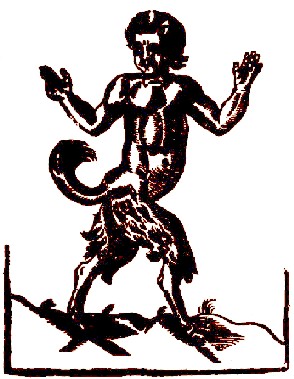 A Monster half man and half dog, The Workes of That Famous Chirurgion Ambroise Parey, p. 662 (1649) |
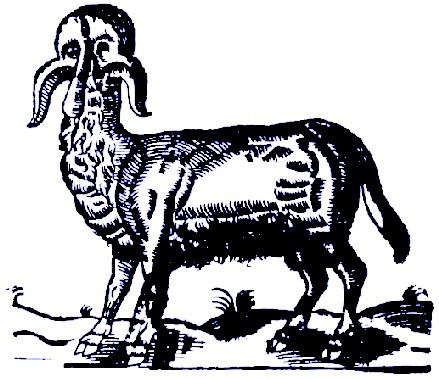 A Monster in the facer resembling a man, but a Goat in his other Members, from The Workes of That Famous Chirurgion Ambroise Parey, p. 663 (1649) |
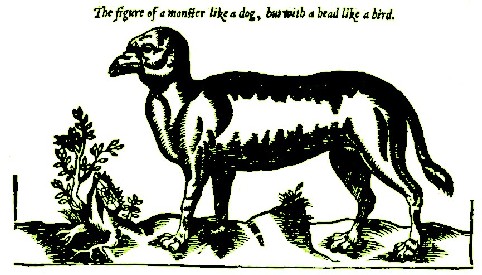
The Original Bird Dog (a Monster), From The
Workes
of That Famous
Chirurgion
Ambroise
Parey, p. 664 (1649)
Anno Dom. 1571. at Antwerp, the wife of one of one Michael a Printer dwelling with one John Molline a Graver or Carver, at the sign of the Golden Foot, in the Camistrate, on St. Thomas his daie, at ten of the clock in the morning, brought forth a monster wholly like a dog, but that it had a shorter neck, and the head of a bird, but without anie fethers on it.
This monster was not alive, for that the mother was delivered before her time; but shee giving a great scritch in the instant of her deliverance, the chimnie of the hous fell down, yet hurt no bodie, no not so much as anie one of four little children that sate by the fire-side."7
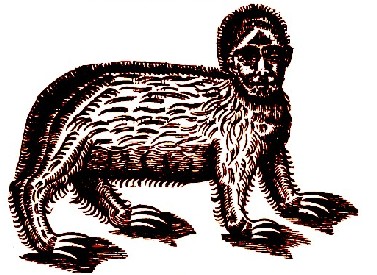
The Haitt, From The
Workes
of That Famous
Chirurgion
Ambroise
Parey, p. 691 (1649)
"The following monster [at left] is so strange that it will scarce bee believed, but by those that have seen it: it is bred in America, and by the Salvages called Haitt, of the bigness of a Monkie, with a great bellie, almost touching the ground, and the head and face of a childe: beeing taken, it mourn's and sigh's like to a man that is troubled and perplex; it is of an ash-color, hath the feet divided into three claws, four fingers long, and sharper then those of a Lion: it climbe's trees, and live's there more frequently then upon the ground, the tail is no longer than the bredth of three fingers.
It is strange and almost monstrous that these kinde of creatures have never been seen to feed upon, or eat anie thing: for the Salvages have kept them long in their houses to make trial thereof, wherefore they think them to live by the air."8
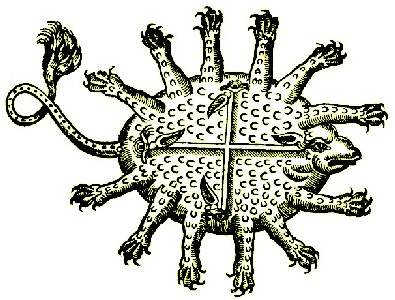
The African Tortoise Monster, From The
Workes
of That Famous
Chirurgion
Ambroise
Parey, p. 692 (1649)
"I have taken this following monster [at right] out of Leo's African histoire; it is verie deformed, being round after the manner of a Tortois, two yellow lines crossing each other at right angles, divide his back; at everie end of which hee hath one eie, and also one ear, so that such a creature may see on everie side with his four eies, as also hear by his so manie ears: yet hath hee but one mouth, and one bellie to contain his meat, but his round bodie is encompassed with manie feet, by whose help hee can go anie waie hee pleas without turning of his bodie, his tail is something long and verie hairie at the end.
The inhabitants affirm, that his blood is more effectuall in healing of wounds then anie balsom."9
There are actually several other land-based monsters in Paré's account. I have focused on the more fantastic ones here. You may have noticed that Paré occasionally comments on the healing properties that the monsters he describes may be contain, as befits his role as a surgeon.
1 Ambroise Paré, The Workes of that Famous Chirurgion Ambrose Parey, p. 648; 2 Paré, ibid.; 3 Paré, p. 678; 4 Paré, p. 660; 5 Paré, p. 662; 6 Paré, p. 663; 7 Paré, p. 664; 8 Paré, p. 691;;

